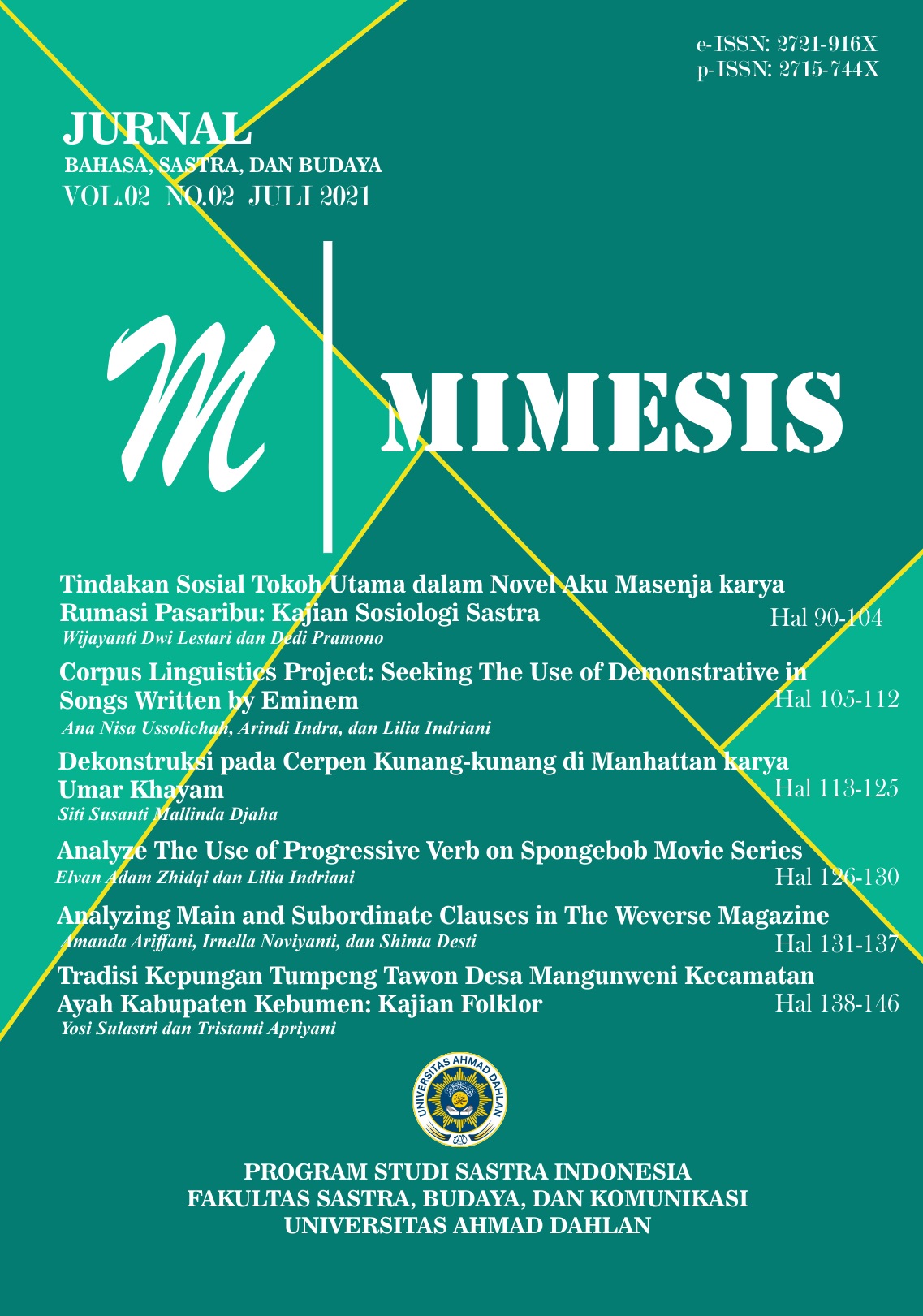TRADISI KEPUNGAN TUMPENG TAWON DESA MANGUNWENI KECAMATAN AYAH KABUPATEN KEBUMEN: KAJIAN FOLKLOR
DOI:
https://doi.org/10.12928/mms.v2i2.4328Keywords:
Folklore, Oral Literature, Tradition, Tumpeng TawonAbstract
This research is motivated by the existence of oral literature on the tradition of the tumpeng wasp siege that has not been documented in Mangunweni Village, Ayah District, Kebumen Regency. Oral literature has information that can be utilized by the public. Through documentation, this information can be opened and used so that the objectives of describing oral literature, deciphering the value of oral literature, and identifying the function of oral literature can be achieved. The theory used in this research is the theory of the function of folklore by William R. Bascom and the theory of folklore proposed by Ruth Finnegan that oral literature has value in the phenomenon of human culture.
The formal object of this research is the form, function, and value of oral literature. The material object in this study is oral literature in the tradition of the tumpeng wasp siege of the people of Mangunweni Village, Ayah District, Kebumen Regency. The analysis technique used is qualitative data analysis conducted by induction.
The results obtained from this study are: 1) the oral literature of the tumpeng tawonsiege tradition is a type of oral tradition in the form of myths and folk beliefs; 2) the values contained in the tumpeng wasp siege tradition consist of divine values, harmony between humans, equality between humans, diversity, sincerity, unyielding, usefulness to others, and concern in achieving goals; 3) the tumpeng wasp siege tradition has a function as a projection system, as a tool for ratifying cultural institutions and institutions, as an educational tool (pedagogical device), and as a coercive and supervisory tool so that community norms will always be obeyed by members.
References
Ananda, R. (2017). Kajian fungsi sastra sisan Kaba Urang Tanjuang Karang pada pertunjukan Dendang Pauah. Semantik, 4 (2). 92-122. Diambil dari https://e-journal.stkipsiliwangi.ac.id.
Budianto, V. I. M. (1999). Realitas dalam simbol Wiwahan atau simbol Wiwahan dalam sealitas: suatu refleksi terhadap tradisi Jawa. Wacana, 1 (1). 119-132. Diambil dari https://brill.com.
Danandjaja. (1986). Folklor Indonesia. Jakarta: Pustaka Grafitipers.
Endraswara, S. (2013). Folklor nusantara: hakikat, bentuk, dan fungsi. Yogyakarta: Penerbit Ombak.
Endraswara, S. (2017). Metodologi penelitian kebudayaan. Yogyakarta: Gadjah Mada University Press.
Jatmiko, A., Masruri, A., Rosyadi, M. M., Istikomah, T. Setiyani, H., Noviyana, E., Lestyari, T., Salamah, U., Ikhsanah, Z. (2020). Laporan Kelomok Pelaksanaan Kuliah Kerja Nyata (KKN), Institut Agama Islam Nahdlatul Ulama (IAINU).
Muslimin, M. F., & KM, J. U. S. (2019). Aspek kelisanan dan fungsi pada Mantra Bato Peter, mitos menstruasi, mantra prosesi drojogan, dan sastra lisan lawas. Totobuang, 7 (2). 349-360. Diambil dari https://totobuang.kemdikbud.go.id/jurnal/index.php/totobuang/article/view/150/104
Puspitasari, A. (2012). Kajian folklor tradisi merti Dhusun di Dusun Tugono Desa Kaligono Kecamatan Kaligesing Kabupaten Purworejo. Skripsi, tidak diterbitkan, Universitas Muhammadiyah Purworejo.
Wiranata, I. G. A. B. (2011). Antopologi budaya. Bandung: PT Citra Aditya Bakti.
Downloads
Published
Issue
Section
License
Copyright (c) 2021 Yosi Sulastri

This work is licensed under a Creative Commons Attribution-ShareAlike 4.0 International License.
License and Copyright Agreement
In submitting the manuscript to the journal, the authors certify that:
- They are authorized by their co-authors to enter into these arrangements.
- The work described has not been formally published before, except in the form of an abstract or as part of a published lecture, review, thesis, or overlay journal.
- That it is not under consideration for publication elsewhere,
- That its publication has been approved by all the author(s) and by the responsible authorities tacitly or explicitly of the institutes where the work has been carried out.
- They secure the right to reproduce any material that has already been published or copyrighted elsewhere.
- They agree to the following license and copyright agreement.
Copyright
Authors who publish with Mimesis agree to the following terms:
- Authors retain copyright and grant the journal right of first publication with the work simultaneously licensed under a Creative Commons Attribution License (CC BY-SA 4.0) that allows others to share the work with an acknowledgment of the work's authorship and initial publication in this journal.
- Authors are able to enter into separate, additional contractual arrangements for the non-exclusive distribution of the journal's published version of the work (e.g., post it to an institutional repository or publish it in a book), with an acknowledgment of its initial publication in this journal.
- Authors are permitted and encouraged to post their work online (e.g., in institutional repositories or on their website) prior to and during the submission process, as it can lead to productive exchanges, as well as earlier and greater citation of published work.











